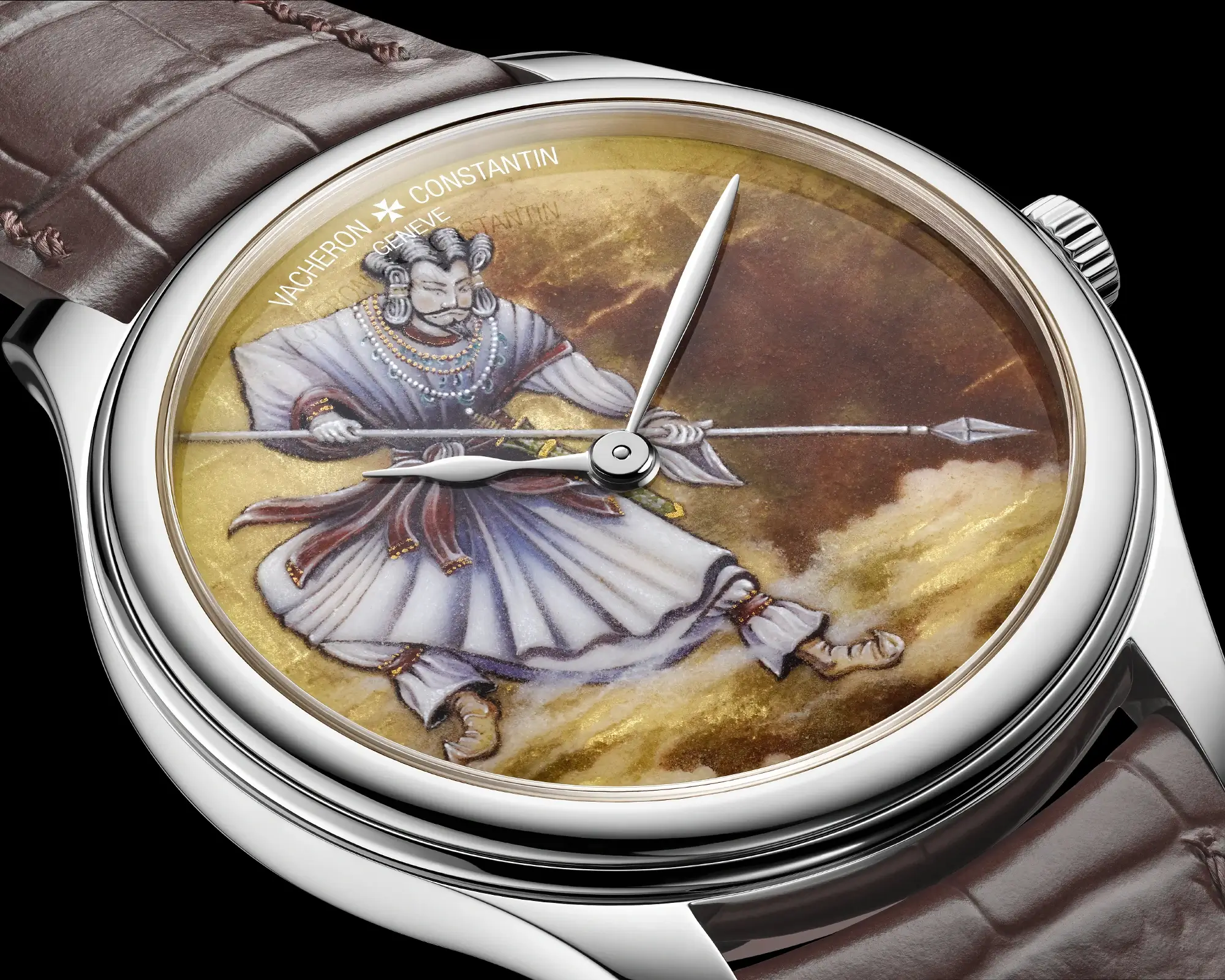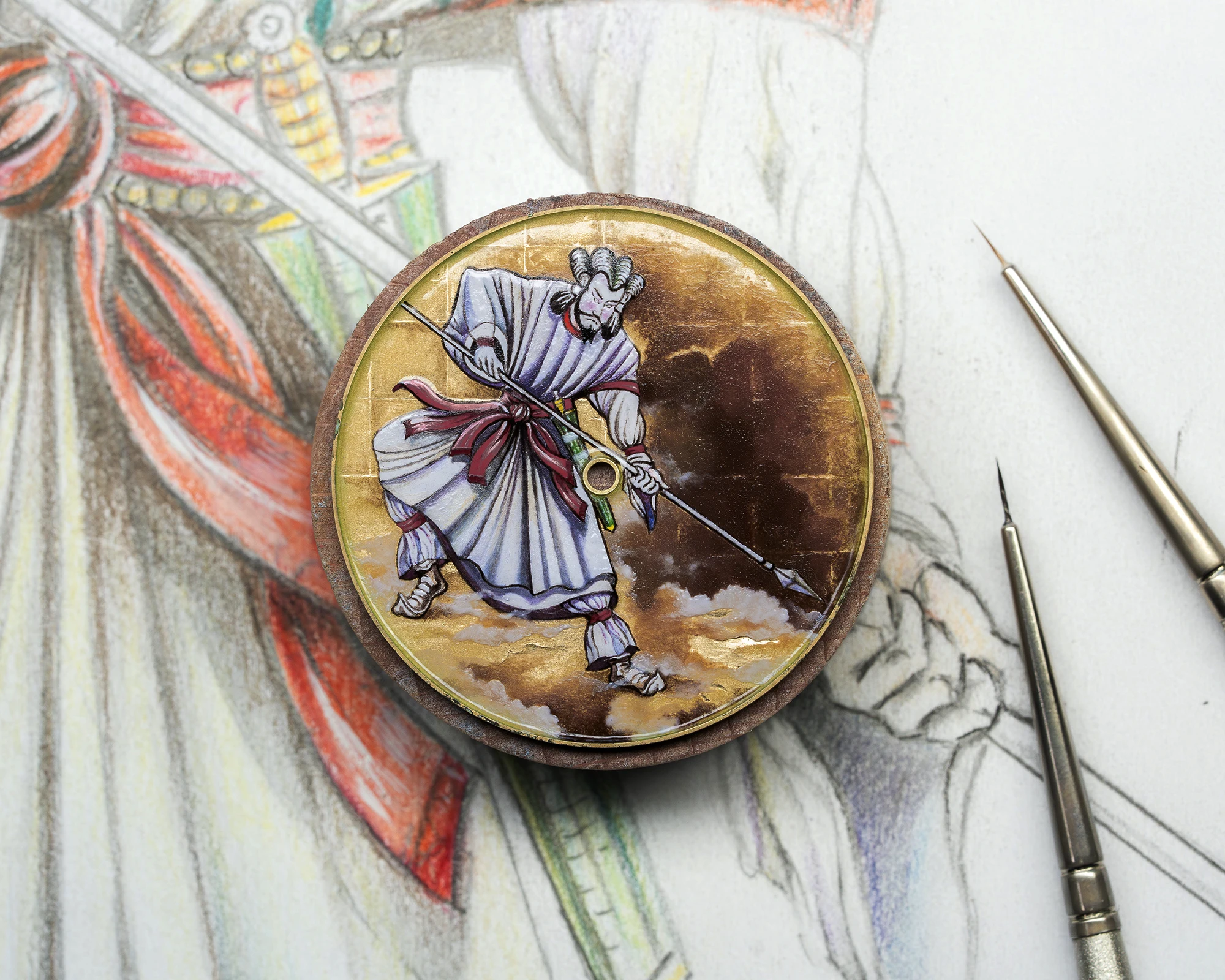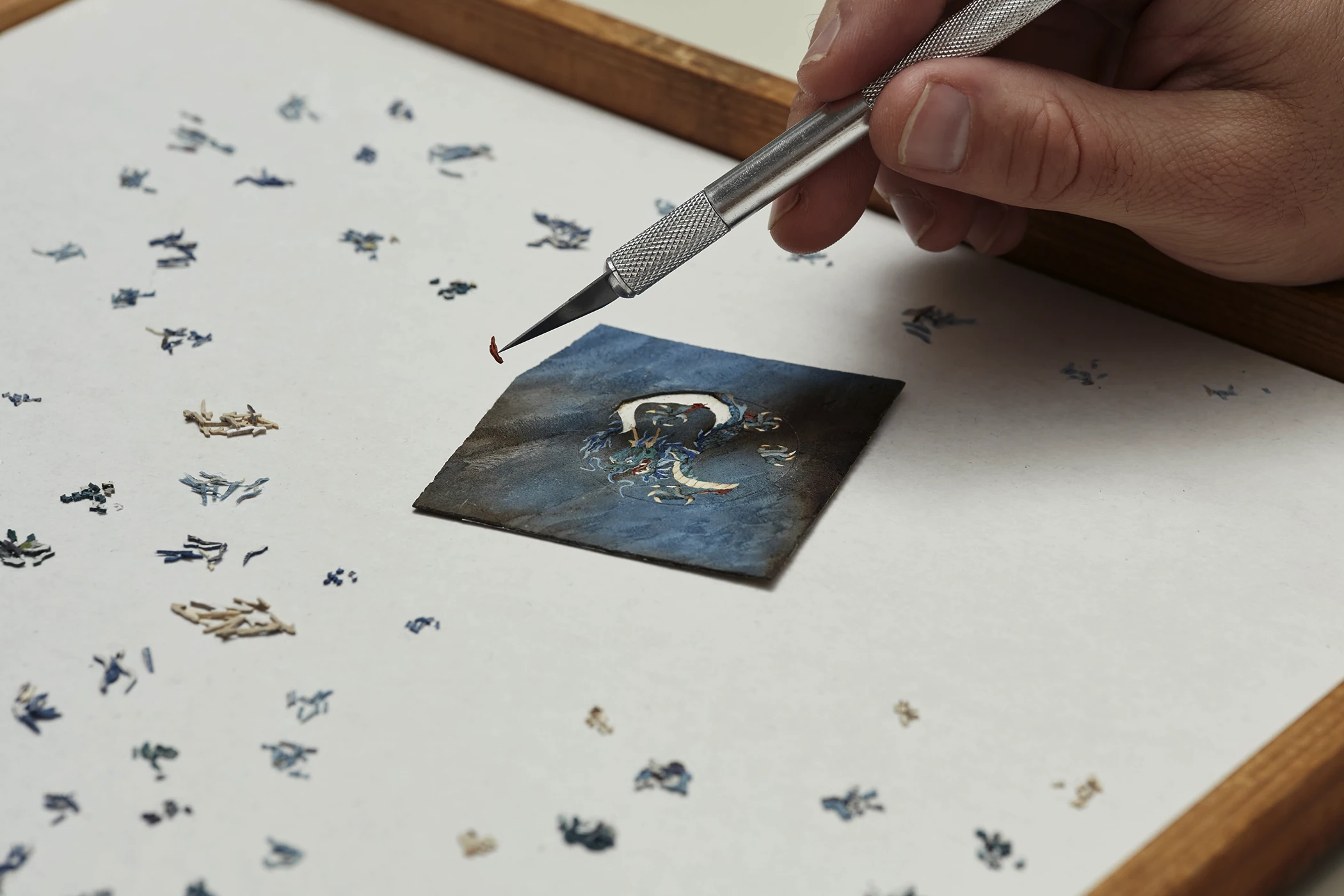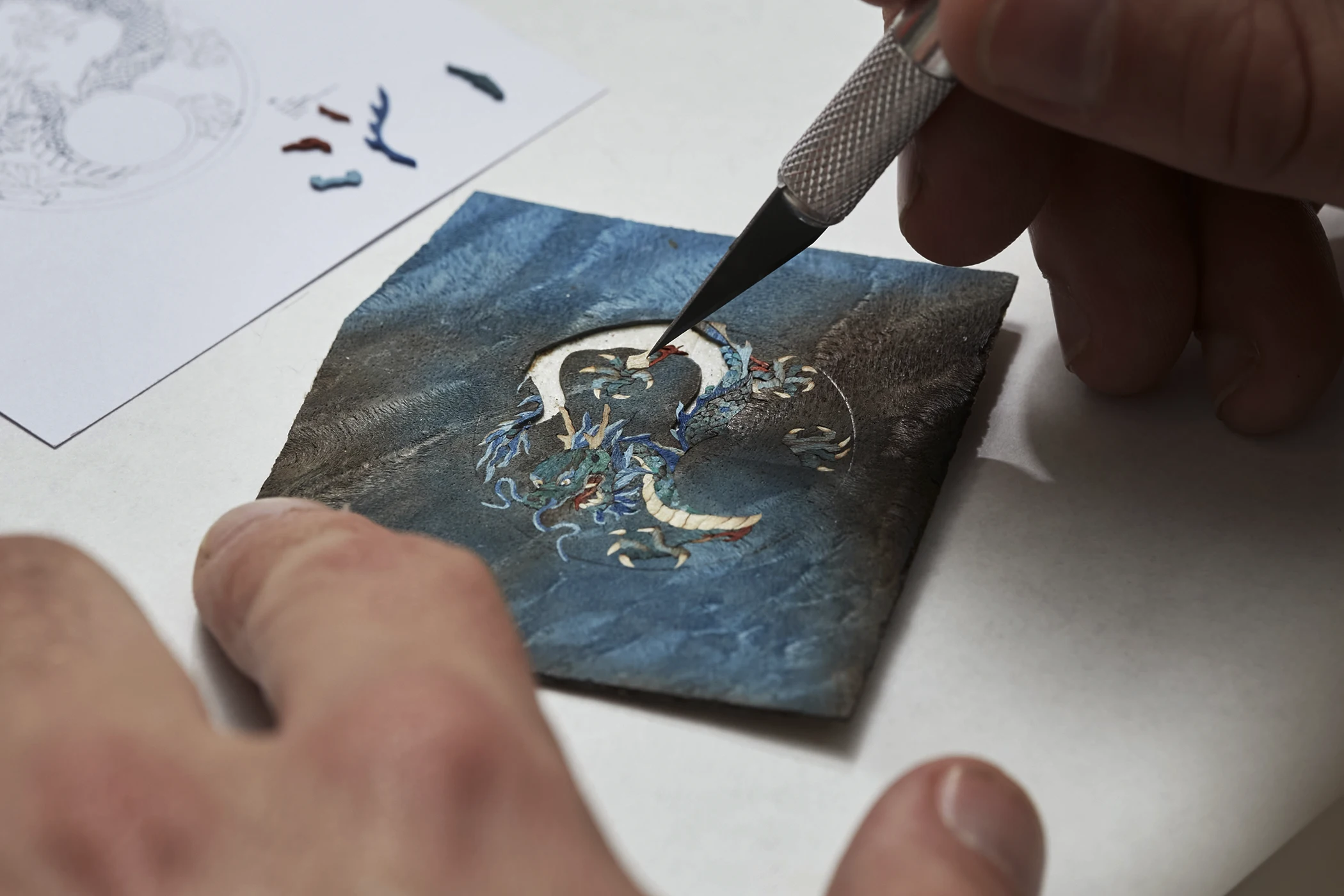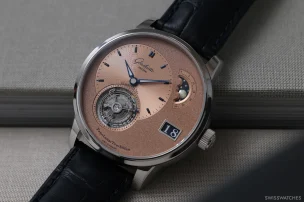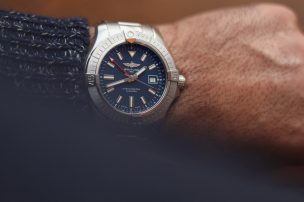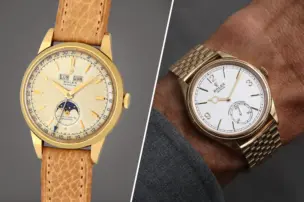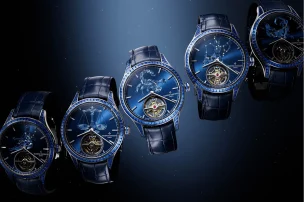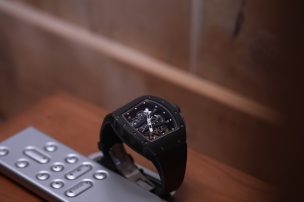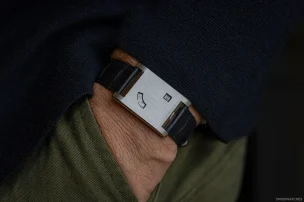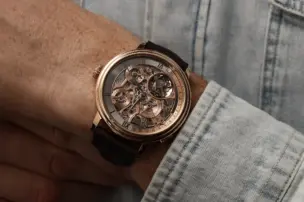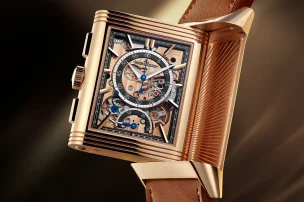
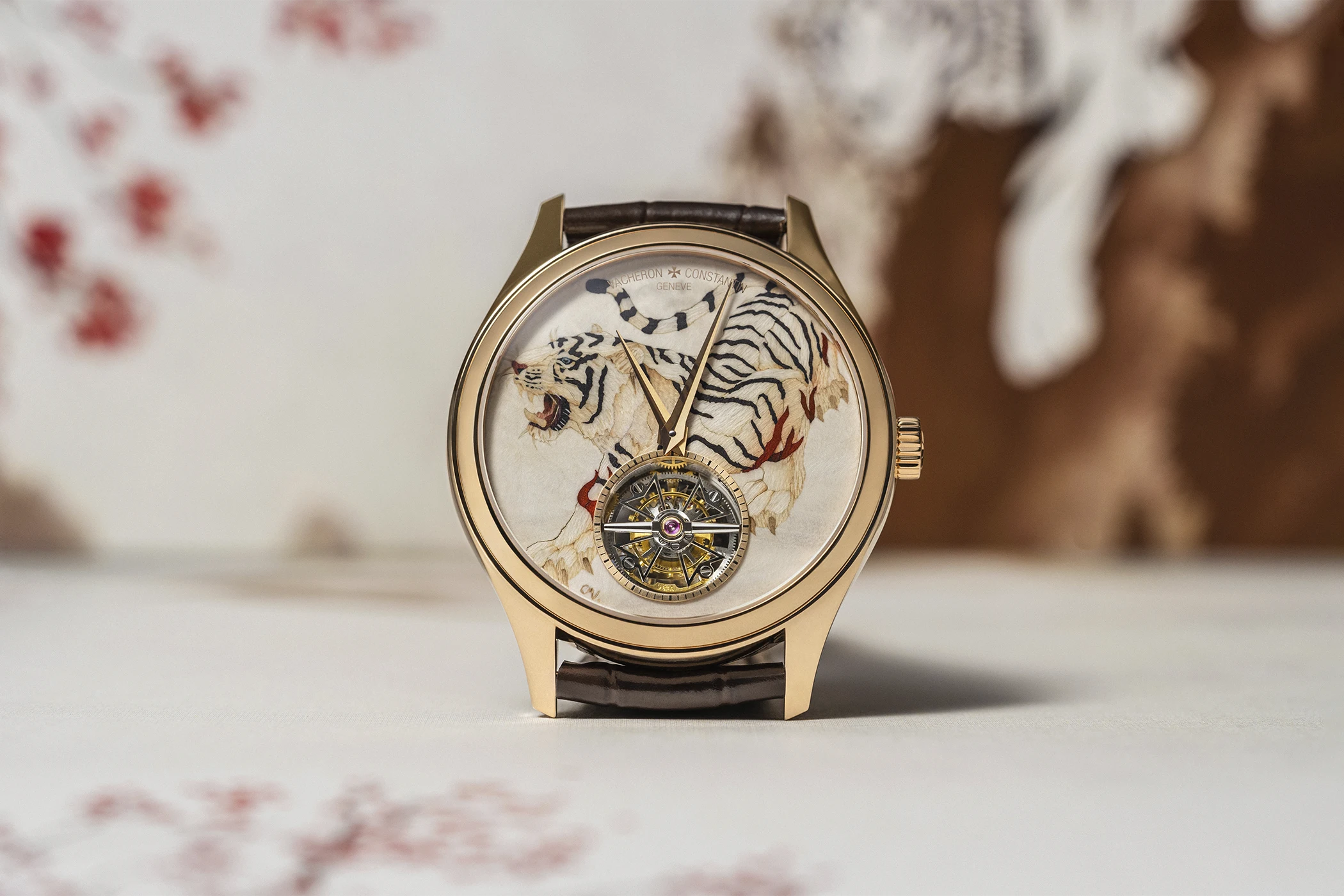
Vacheron Constantin Les Cabinotiers: Unique Creations Draw Inspiration from Japanese Deities, Asian Culture and Greek Mythology
As a somewhat seasoned purveyor of the watch industry by now, I would personally assert that Vacheron Constantin’s Les Cabinotiers is one of the absolute highest watchmaking departments on the planet. Over the years, the Swiss horology house’s unique creations division has produced some of the most complex watches of all time, blending groundbreaking horological innovation with unparalleled traditional craftsmanship.
Vacheron Constantin Les Cabinotiers
For those not yet well-versed in the work of this remarkable workshop: the mission of Vacheron Constantin’s Les Cabinotiers is, in the brand’s words, to revive the spirit of 18th-century Geneva. This was a time when distinguished dignitaries of European courts would commission watches directly from the “Cabinotiers” — Geneva’s elite horological craftsmen, including master watchmakers, enamellers, engravers, and goldsmiths. These master watchmakers would work in ateliers bathed in natural light, known as ‘cabinets’ and located on the top floor of Geneva’s buildings. The artisans were inspired by astronomy, mechanical engineering and the arts.
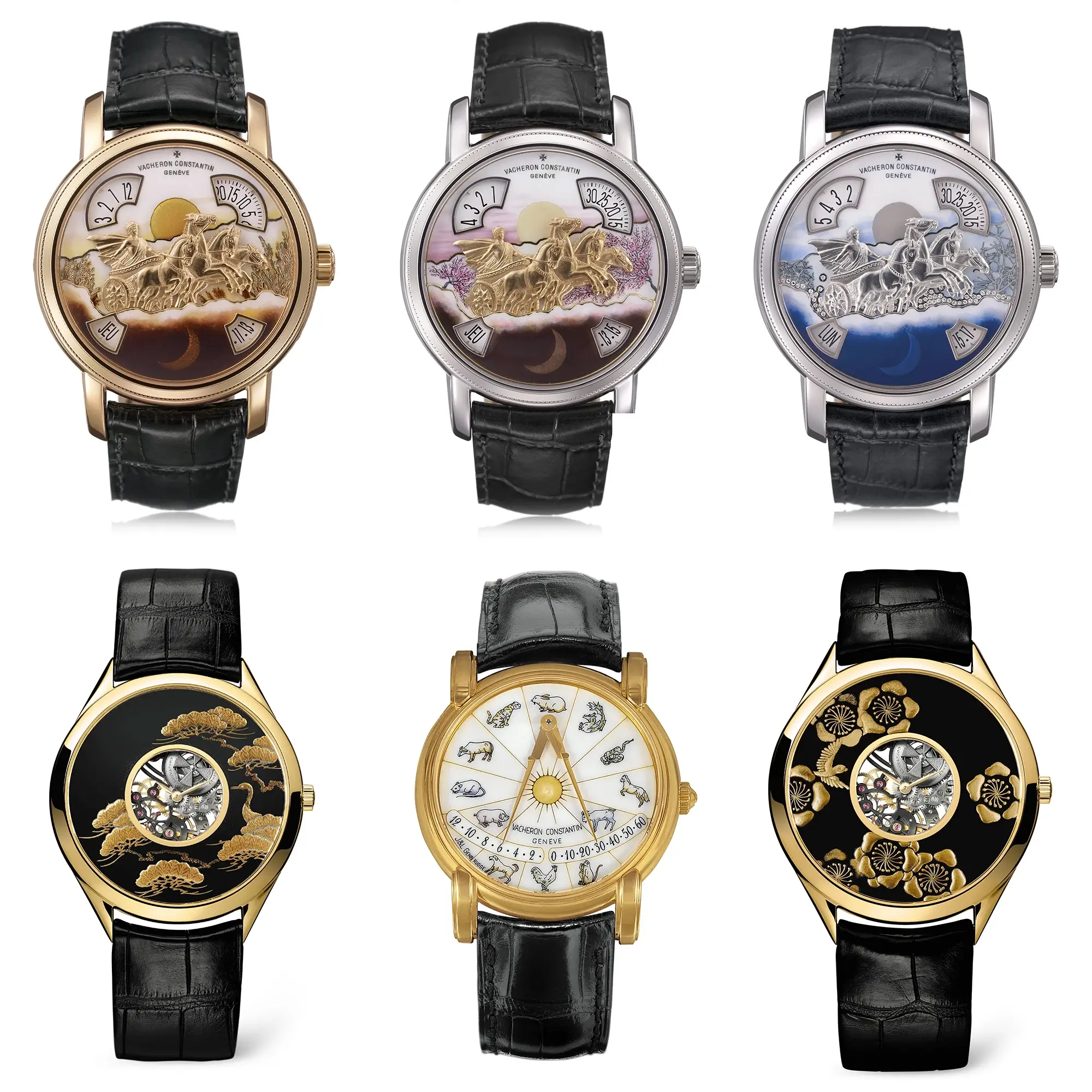
We’ve seen some of the most impressive examples of unique haute horlogerie in modern watchmaking history emerge from Les Cabinotiers, rivalled only by the likes of Patek Philippe’s immensely complex Grandmaster Chime or Cartier’s inaugural Metiers d’Art Ballon Bleu enamel granulation watch from 2016. Now, several new watches are joining their high ranks.
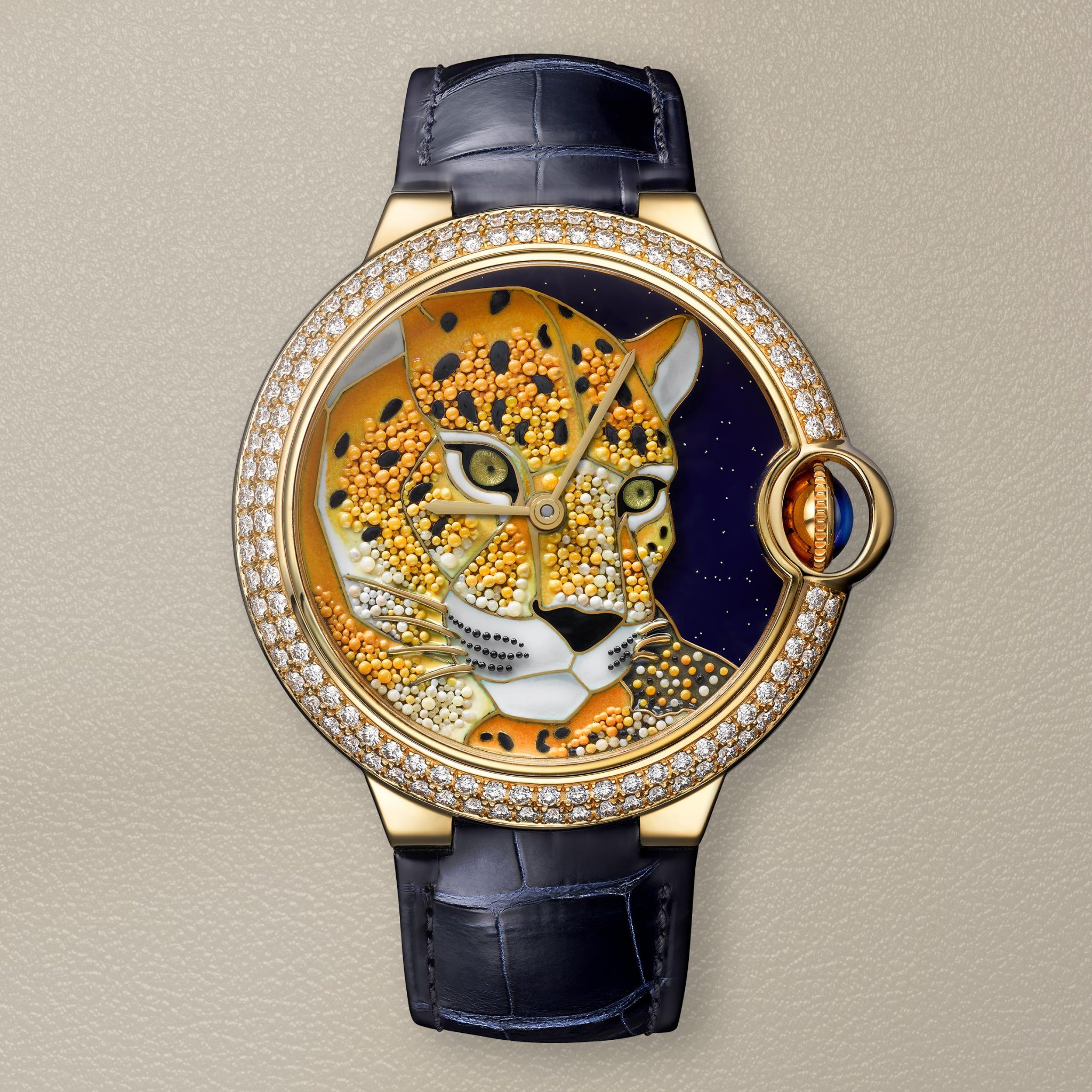
Work of art: The famed and intricately crafted Cartier Ballon Bleu enamel granulation watch
Vacheron Constantin: The Armillary Tourbillon
Almost a decade ago, in 2015, and after eight years of development, the atelier presented the most complicated watch ever made: the pocket watch Reference 57260 with 57 complications. A year later, Vacheron Constantin launched the wristwatch Les Cabinotiers Armillary Tourbillon Ref. 91990/000G-9882 in white gold featuring two of the mechanisms from Reference 57260: the bi-axial armillary tourbillon with spherical balance-spring and the instant retrograde display of the time indication. Forming a sphere in perpetual motion, this special kind of tourbillon was named ‘armillary’ in reference to the 18th century French watchmaker Antide Janvier – and watchmaker to King Louis XVI – who created a spectacular astronomical clock bearing an armillary sphere. This structure consists of two nested carriages moving on two different axes at a speed of 60 seconds per rotation.
Since then, we’ve seen a number of Armillary Tourbillon models in various forms. This time last year, Vacheron introduced a number of additions to its Les Cabinotiers ‘Récits de Voyages’ collection, experimenting with grisaille enamel, wood marquetry and the champlevé enamelling techniques, as well as an armillary tourbillon for which the department is particuarly well known.
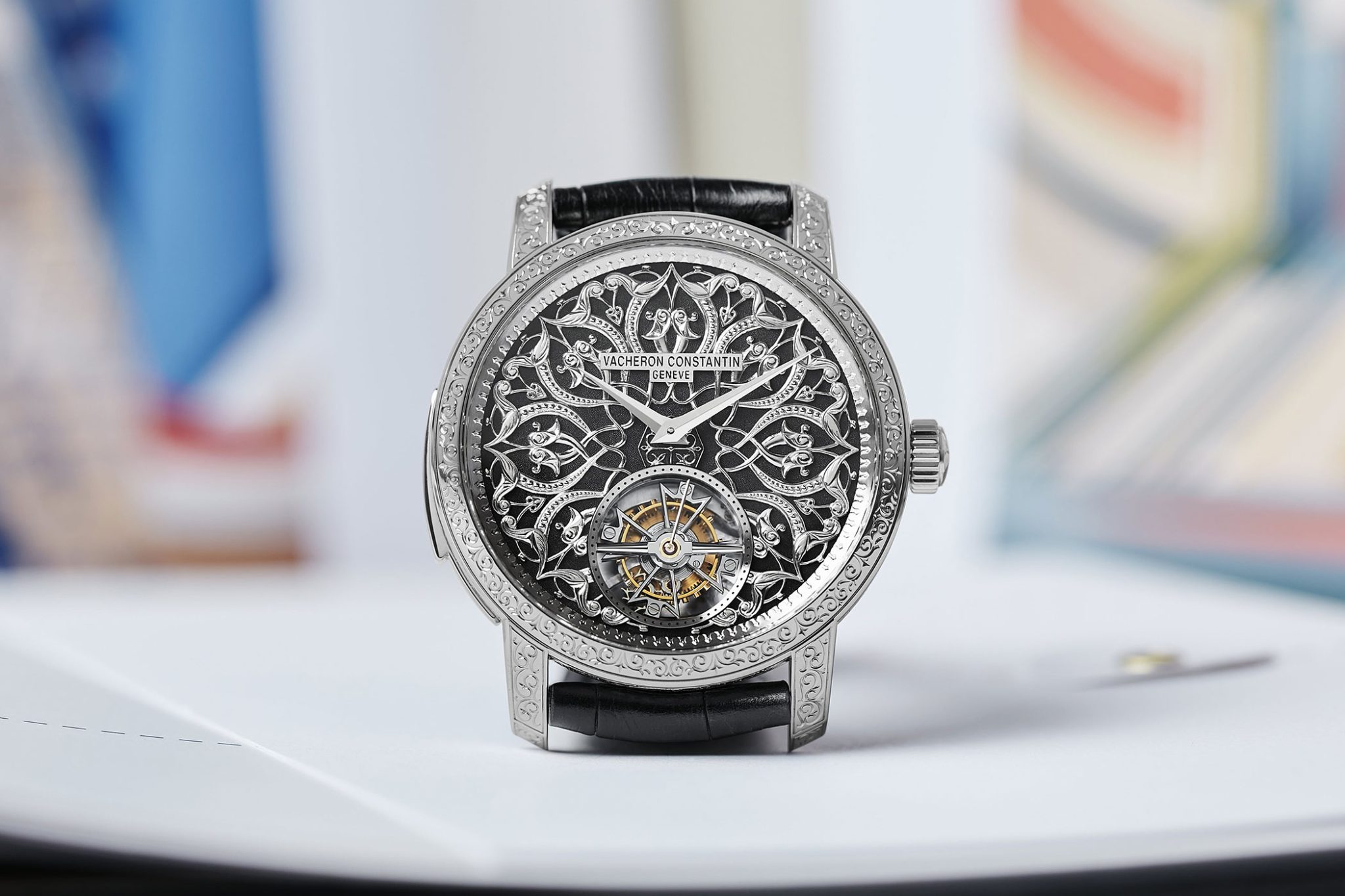
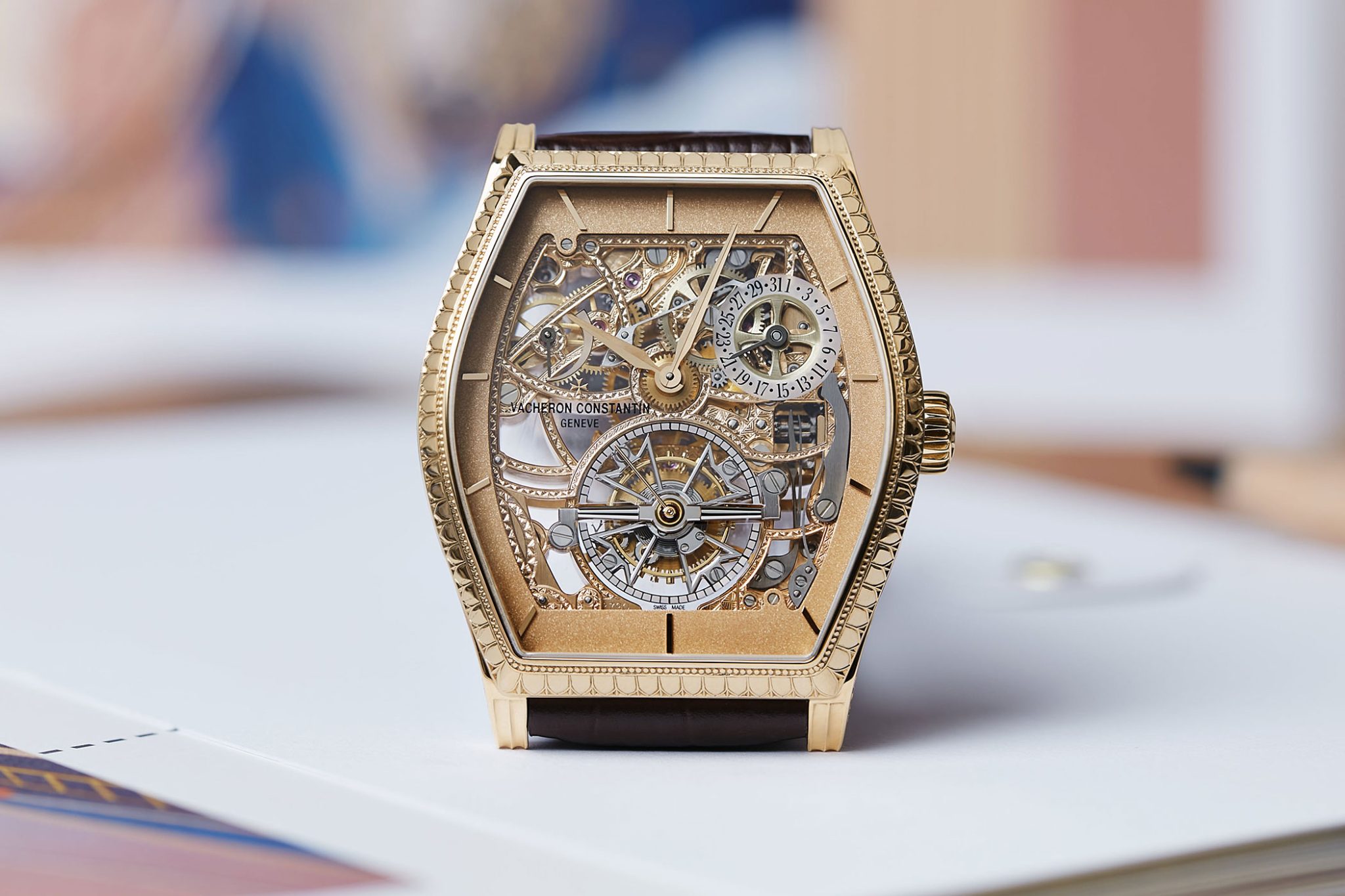
Earlier the same year, Les Cabinotiers also announced the creation of a unique armillary tourbillon watch destined for the dashboard of a Rolls Royce, christened the Amethyst Droptail. Les Cabinotiers is now treating us two Le Temps Divin (Divine Time) editions named ‘Ode to Chronos’ and ‘Tribute to Infinite Time’.
Le Temps Divin ‘Ode to Chronos’ and ‘Tribute to Infinite Time’
The aim of the Les Cabinotiers Le Temps Divin watches is to reimagine time through diverse cultural and philosophical lenses. The two watches, both of which are unique pieces, reflect three main views of time: as a physical, linear sequence; as a cyclical rhythm, like the changing seasons; and as an endless, present moment. Each concept invites a journey into unique cultural landscapes, weaving together horological expertise and artistry.
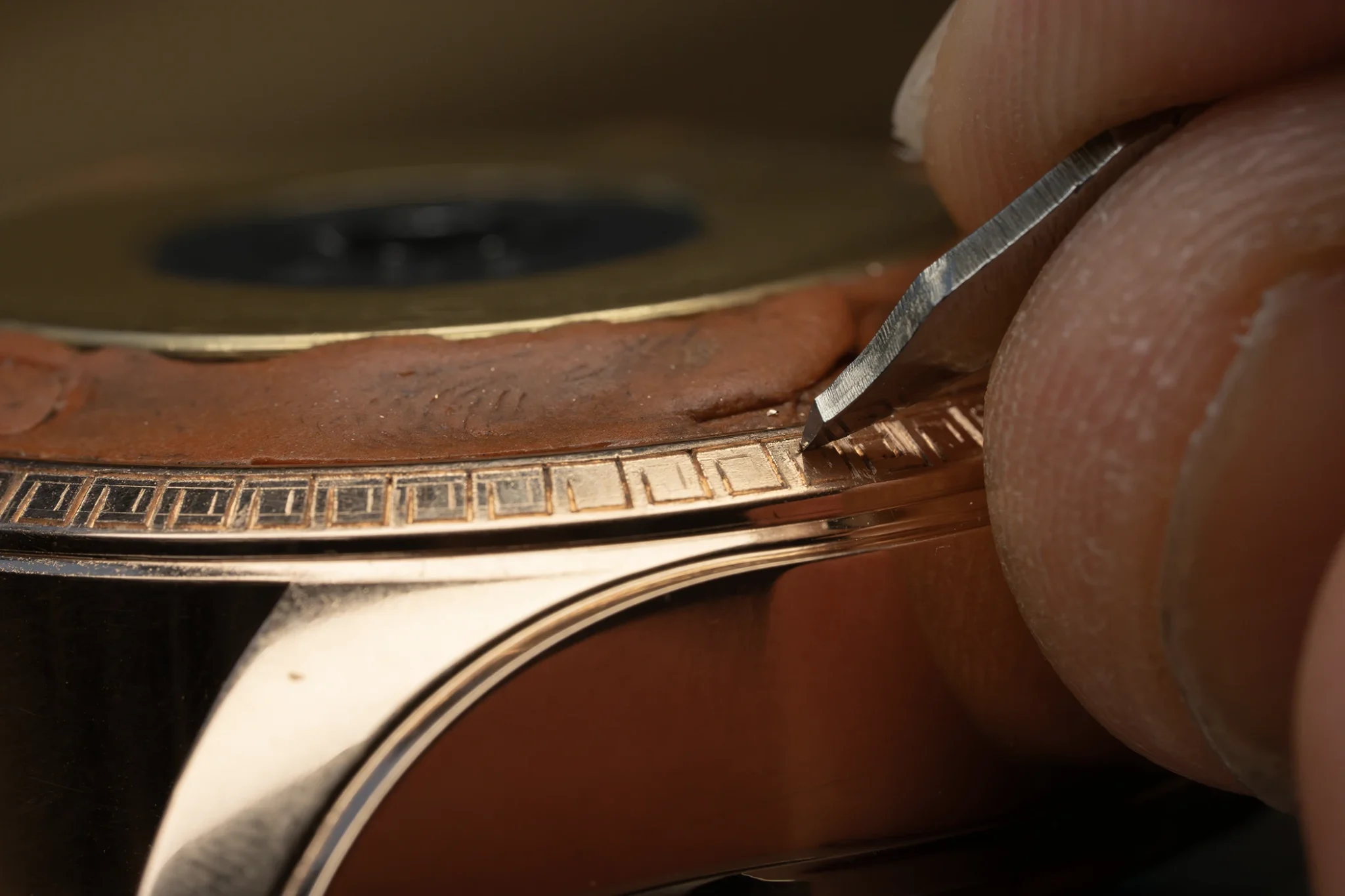
To represent linear, structured time, the Greek god Chronos – Saturn in Roman mythology, and father of the Horae (Hours), the goddesses who personified the division of time – was chosen as a motif. This theme is brought to life in two editions, both powered by the calibre 1990 movement, featuring a bi-axial armillary tourbillon and retrograde hours and minutes, and thus showcasing a brilliant fusion of mechanics and mythology.
The case
Each Les Cabinotiers Le Temps Divin watch symbolising Chronos, the god of linear time, features a meticulously engraved 45 mm case with motifs inspired by Greek and Roman antiquity. The black edition showcases intricate Greek friezes carved along the bezel, pink-gold case middle, lugs, and clasp, with a finely detailed relief of Chronos holding an hourglass at 9 o’clock, which is the result of over 290 hours of engraving.
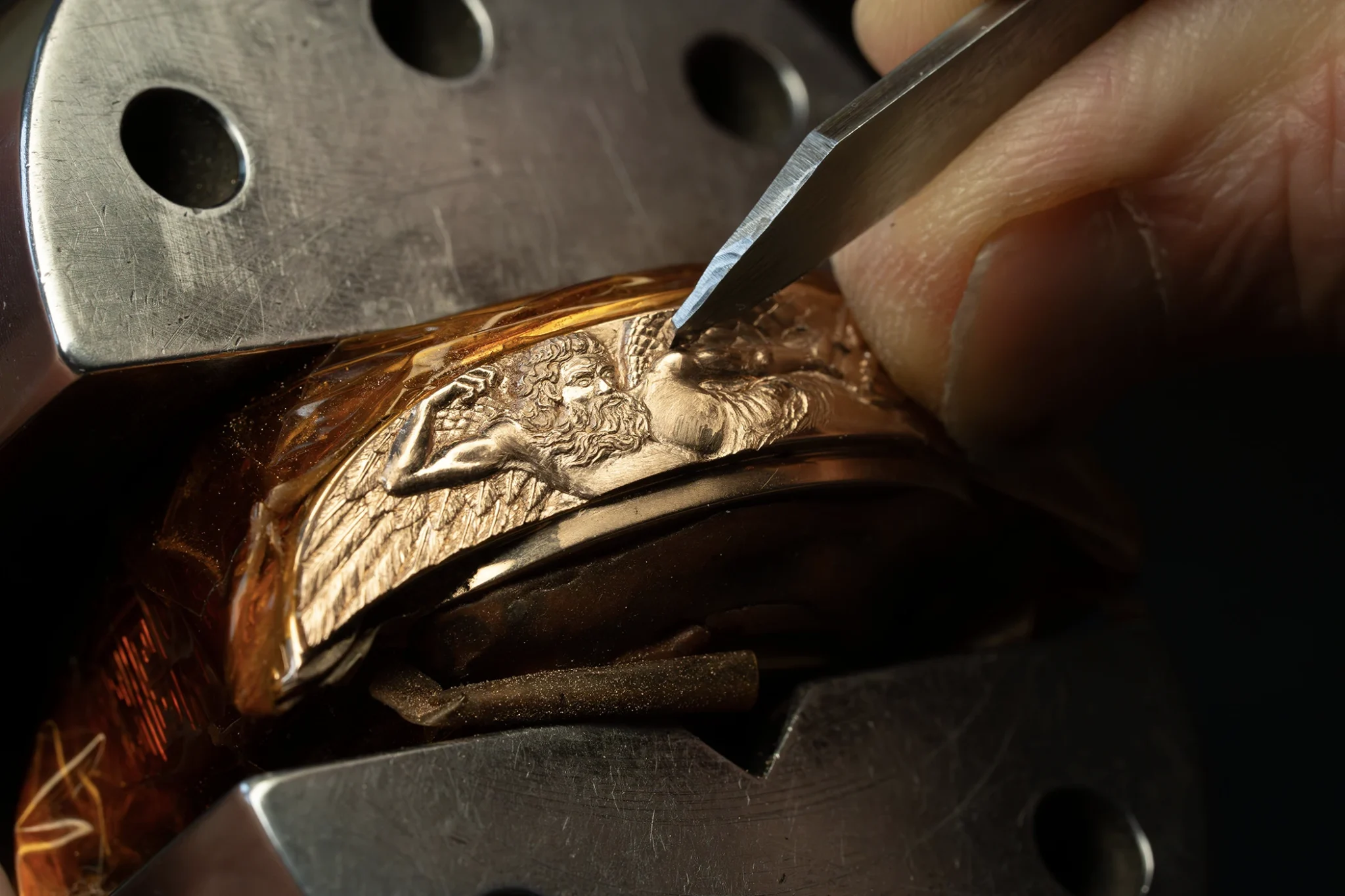
The white-gold model, inspired by the architectural geometry of the Pantheon dome, mirrors the dome’s intricate pattern along the case side. This effect, crafted to appear as a pyramidal depth on a flat surface by using the taille de joue method (changing the angle of the chisel to gradually narrow the furrows between the squares of the motif), demanded 120 hours of expert engraving work. The depiction of figures from the Pantheon or scenes from Hellenic daily life have often inspired Vacheron Constantin’s artisans, as have the most distinctive monuments and decorative elements of these two civilisations, such as the Colosseum in Rome. Both the black and blue models are completed with matching leather straps with emblematic Maltese cross buckles that accentuate the watch’s striking design, creating a cohesive and refined aesthetic.
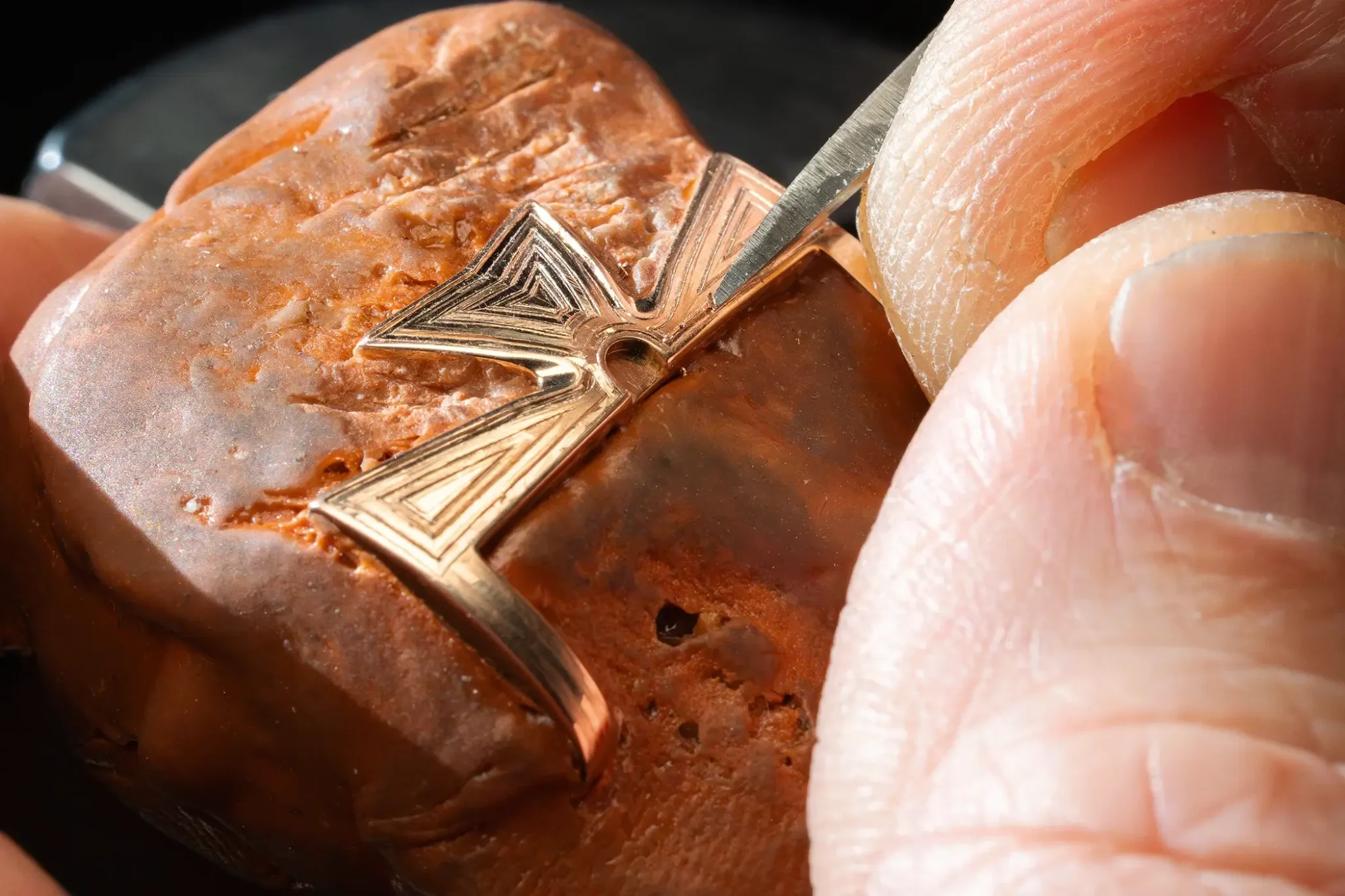
The dial
Meanwhile, the dial design of this series balances technicality and artistry. The ‘Ode to Chronos’ edition showcases a sun satin-finished grey with a circular satin-finished 18K 4N pink gold-coloured hours-markers and minute track, while its sibling boasts a sun satin-finished blue dial with circular satin-finished grey hour-markers and an anthracite minute track.
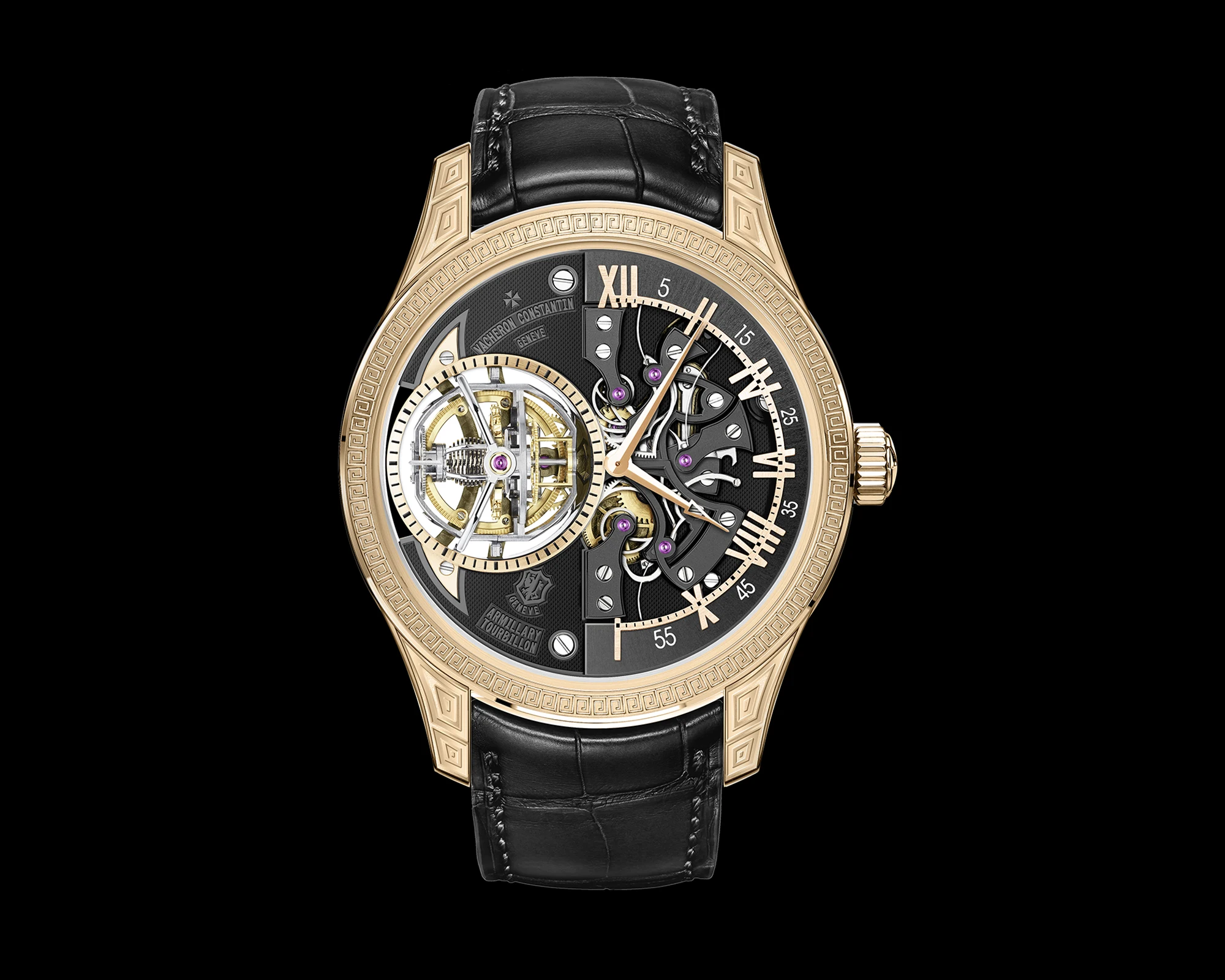
On the right side of both dials, time is displayed via a semi-circular retrograde track with titanium hands gliding over Roman numerals for the hours and Arabic numerals for minutes, allowing glimpses of the mechanism beneath. This adds something of an industrial edge to the otherwise opulent models. The left side of the dial is devoted to the bi-axial armillary tourbillon, positioned at 9 o’clock and encased beneath a sapphire crystal ‘bubble’. The most distinctive feature of this regulator – operating at a rate of 18,000 vibrations per hour and bearing the small seconds hand – is its dual-axis construction with two interlocking aluminium carriages, each rotating at a speed of 60 seconds. At the heart of the tourbillon is a cylindrical balance-spring with no terminal curve, whose perfectly concentric beating ensures greater isochronism and therefore enhanced precision, alongside countering the effects of gravity.
The movement: Calibre 1990
Powering both models is the manual-winding calibre 1990, presented in distinct colour treatments: black via NAC treatment and blue through PVD. This movement incorporates the latest advancements from Vacheron Constantin’s landmark 2015 creation, the Les Cabinotiers Reference 57260. As explained, the calibre 1990 is distinguished by its bi-axial armillary tourbillon and instantaneous bi-retrograde time display, which operate in harmonious tandem.
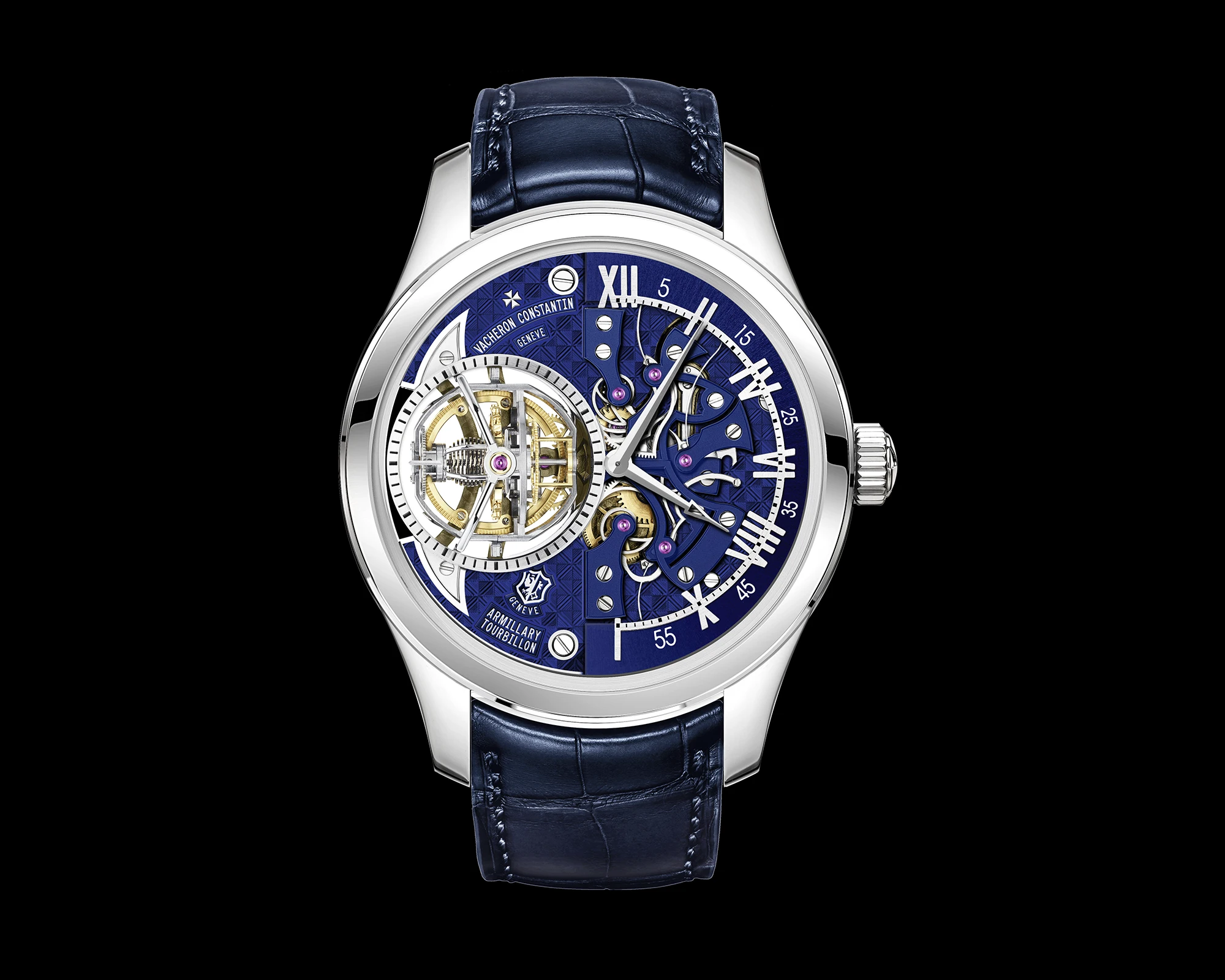
The technical prowess of the calibre 1990
Inspired by horological history, the armillary tourbillon nods to aforementioned watchmaker Antide Janvier’s planetary mechanisms, while the cylindrical balance spring recalls Jacques-Frédéric Houriet’s 1814 invention. The movement’s escapement features a silicon escape wheel and pallet-lever, diamond-polished for optimal durability and reduced friction, underscoring the technical refinement within. The calibre 1990 is protected by four patents covering innovations such as its synchronised retrograde display, a titanium balance-spring attachment that boosts precision, a tourbillon carriage that forms the shape of Vacheron Constantin’s Maltese cross every 15 seconds, and the diamond-polished silicon pallet-lever for reduced wear.
Complementing the technical prowess, traditional decorative crafts are evident throughout the movement. Indeed, a master guillocheur was also involved in embellishing the calibre. Thus, the mainplate and bridges are adorned with a hand-guilloché Clous de Paris hobnail pattern that mirrors the case engravings, while the caseback bears the Latin inscription ‘Carpe Diem’, echoing the theme of seizing time’s fleeting nature. The calibre 1990 has a 60-hour power reserve.
Les Cabinotiers Le Temps Divin: Japanese mythology
The next works of art by Les Cabinotiers draw inspiration from Japan. Once again, each timepiece in this series is a unique, single-edition masterpiece within the Les Cabinotiers Le Temps Divin series, this time representing the metaphysical concept of time through Japanese symbolism. To embody this metaphysical time, three figures or ‘kami’ (in Japanese, kami (神) refers to a spirit, deity, or divine being) were chosen: Izanagi, Amaterasu and Konohanasakuya-hime. The divinities and their respective environments come to life on dials borne from a subtle yet highly sophisticated combination of intaglio engraving, grisaille enamel and miniature enamel. Let’s take a closer look.
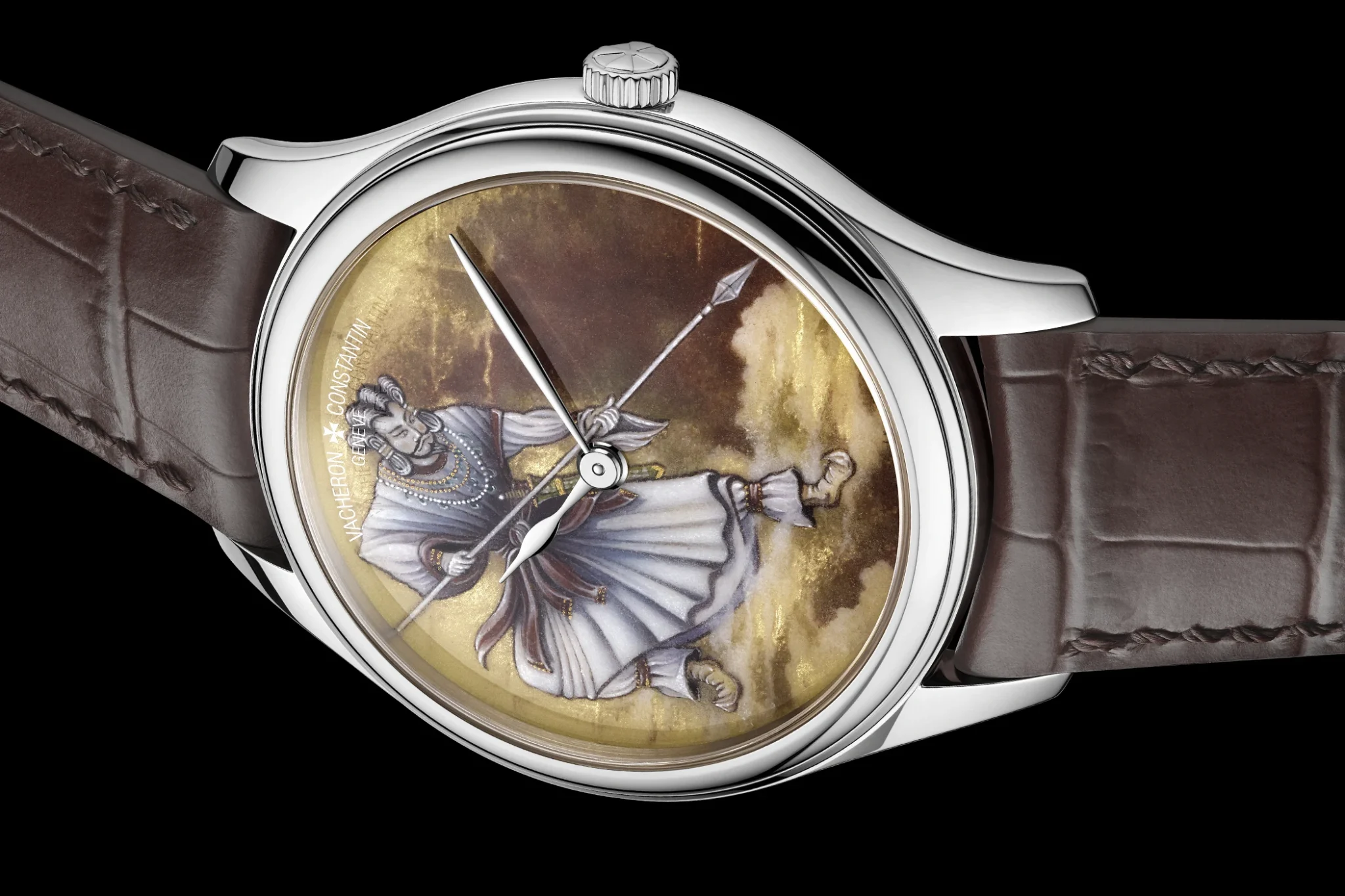
The cases
The watches feature finely crafted cases that set the stage for the deities, honouring Vacheron Constantin’s tradition of exploring mythical and cultural themes through watchmaking. Each case is shaped to frame and enhance the intricate scenes of the gods and their cosmic realms, underscoring the maison’s dedication to artistry and precision. Thus, the white-gold case of the ‘Ode to Izanagi’ has a 40 mm diameter and officer caseback, the white-gold ‘Ode to Konohanasakuya-hime’ models has a 36 mm diameter and transparent caseback, while the glowing ‘Ode to Amaterasu’, aka the sun goddess, has a warm 36 mm 2N yellow-gold case. The straps accompanying each watch is crafted from leather, providing an understated finish that allows the intricate dial art to remain the focus. Together, the straps, cases, and movements support each kami’s symbolism, creating a holistic piece that invites wearers into a profound interpretation of metaphysical time.
The dials
Decoration of the dials
The creation of each dial begins with the master engraver using intaglio engraving to define the deities’ celestial surroundings, such as mist, clouds, and ocean waves. This technique, commonly used in printmaking, involves carving microgrooves just a few hundredths of a millimetre deep, which produces delicate barbs of metal that lend a velvety, reflective quality to the engraved surfaces. Each engraving session lasts about 20 hours, after which the dial is coated with a layer of protective translucent flux.
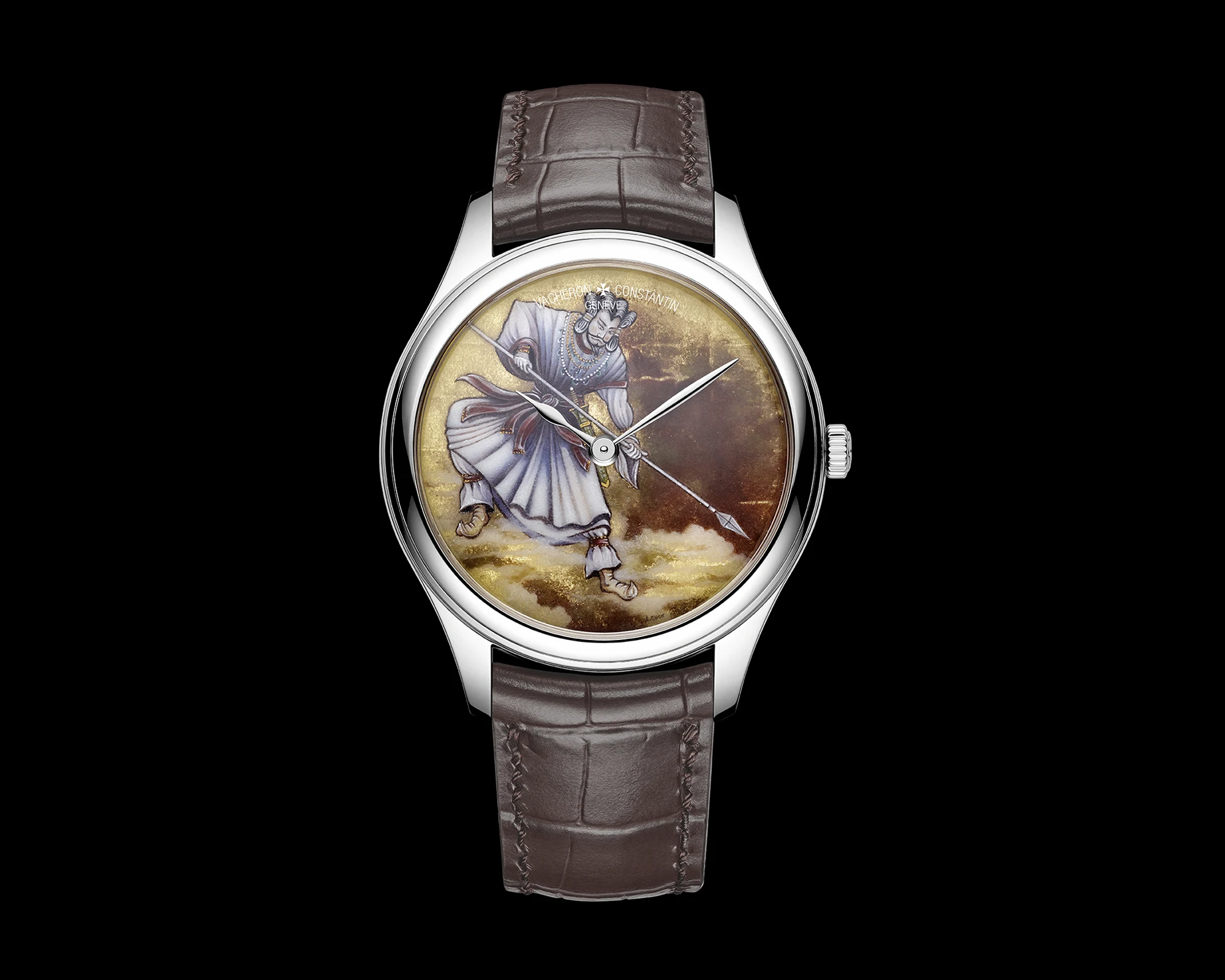
Once engraved, the dials move to the enameller, who begins by defining the gods’ silhouettes using Limoges white, a special enamel powder ideal for soft shadowing. Two coats are fired to set the contours, then, using ultra-fine brushes, the enameller carefully paints the scenes in miniature enamel. Achieving the rich colours and detailed designs requires six to seven coats of enamel, each fired between 800° and 900°C. This painstaking process culminates in two layers of translucent enamel, stone-polished to enhance depth and radiance. Each dial requires nearly three weeks to complete.
Telling the tale of every dial
The dials showcase the three prominent characters — Izanagi, Amaterasu, and Konohanasakuya-hime — each depicted off-centre in the traditional Japanese style. The dials are crafted with a sophisticated combination of intaglio engraving, grisaille enamel, and miniature enamel, combining artistry and depth to capture the mythical narratives.
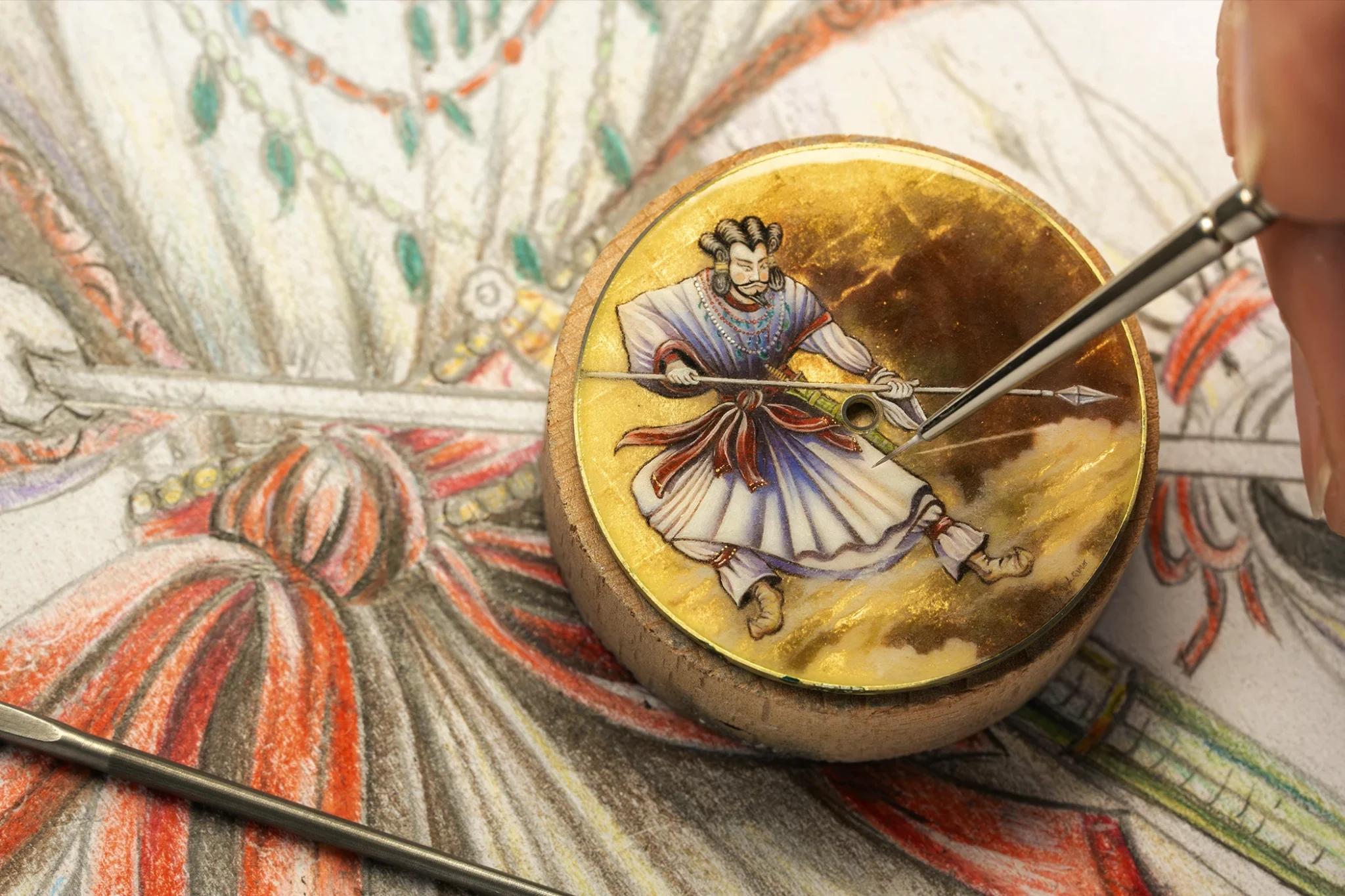
Izanagi, the god of creation, is portrayed on the first watch wielding his sacred spear over the ocean, symbolising the formation of Japan. With fluid, mist-like forms surrounding him, he appears to bring order to primordial chaos.
Amaterasu, the sun goddess, features on the second model, dressed in vibrant ceremonial attire and symbolically carrying a sakaki branch and the solar disc, reflecting her status as both creator and protector of the imperial line. Her radiant presence recalls the solar disc emblem on Japan’s flag and captures her association with rice and silk, the lifeblood of Japanese civilisation.
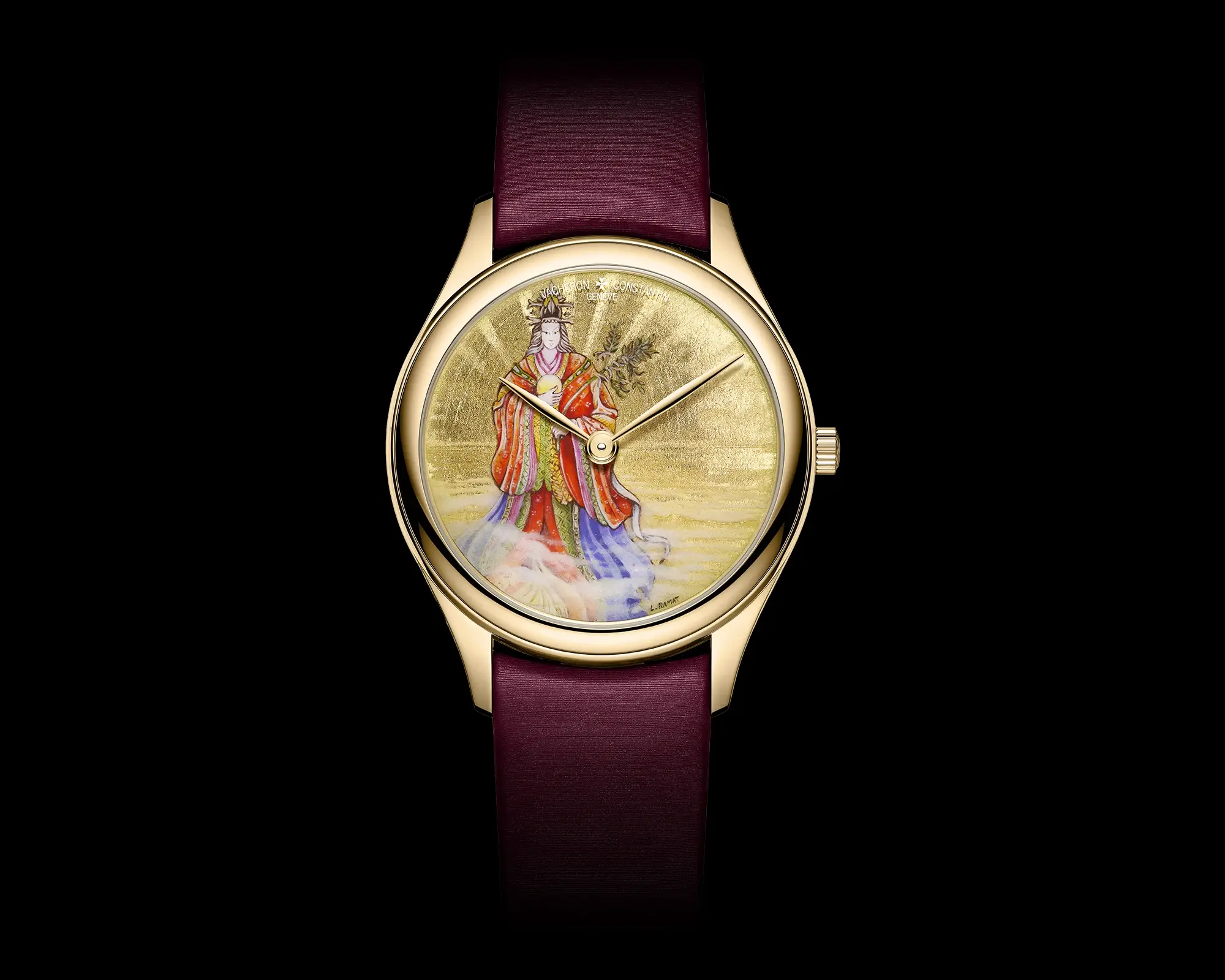
Finally, Konohanasakuya-hime, goddess of Mount Fuji and all volcanoes, graces the third watch in the iconic jūnihitoe costume with twelve layers that symbolise seasonal harmony. Surrounded by moonlight and cherry blossoms, she embodies the fleeting beauty of life. In the background, the mist-shrouded silhouette of Mount Fuji represents her watchful protection over Japan’s landscape.
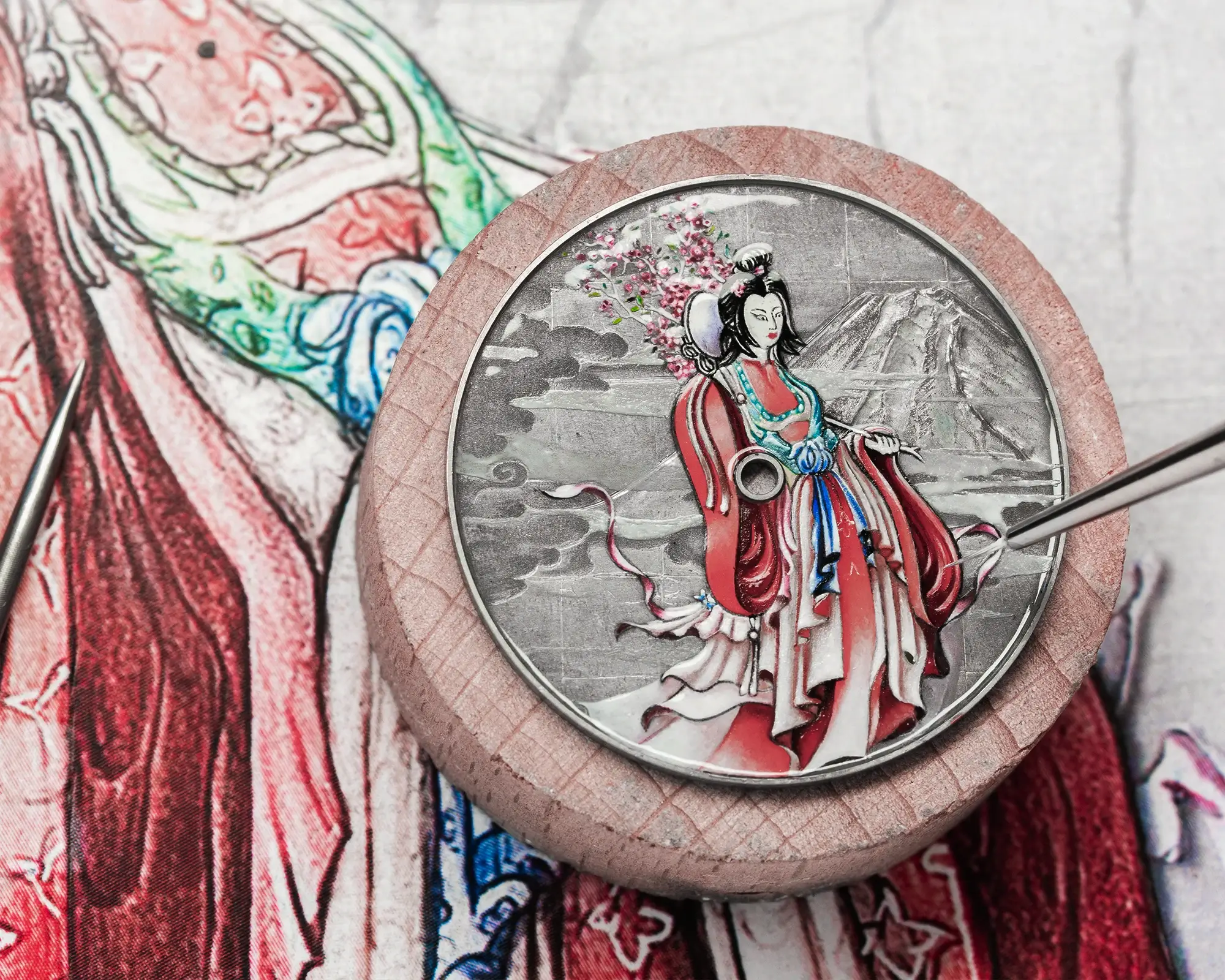
The movements
Each watch in this series contains a finely tuned Vacheron Constantin self-winding time-only movement, allowing the ethereal presence of the kami to take centre stage on the dial. The movements exemplify traditional watchmaking expertise, creating a quiet backdrop for the striking dial art while maintaining optimal precision. Powering the ‘Ode to Izanagi’ edition is the calibre 2460, offering a reliable 40 hour power reserve and beating at a frequency of 3 Hz. Meanwhile, the movement driving the ‘Konohanasakuya-hime’ edition is the calibre 1440, offering a slightly higher reserve of 42 hours and increased frequency of 4 Hz. The ‘Ode to Amaterasu’ edition uses the same movement.
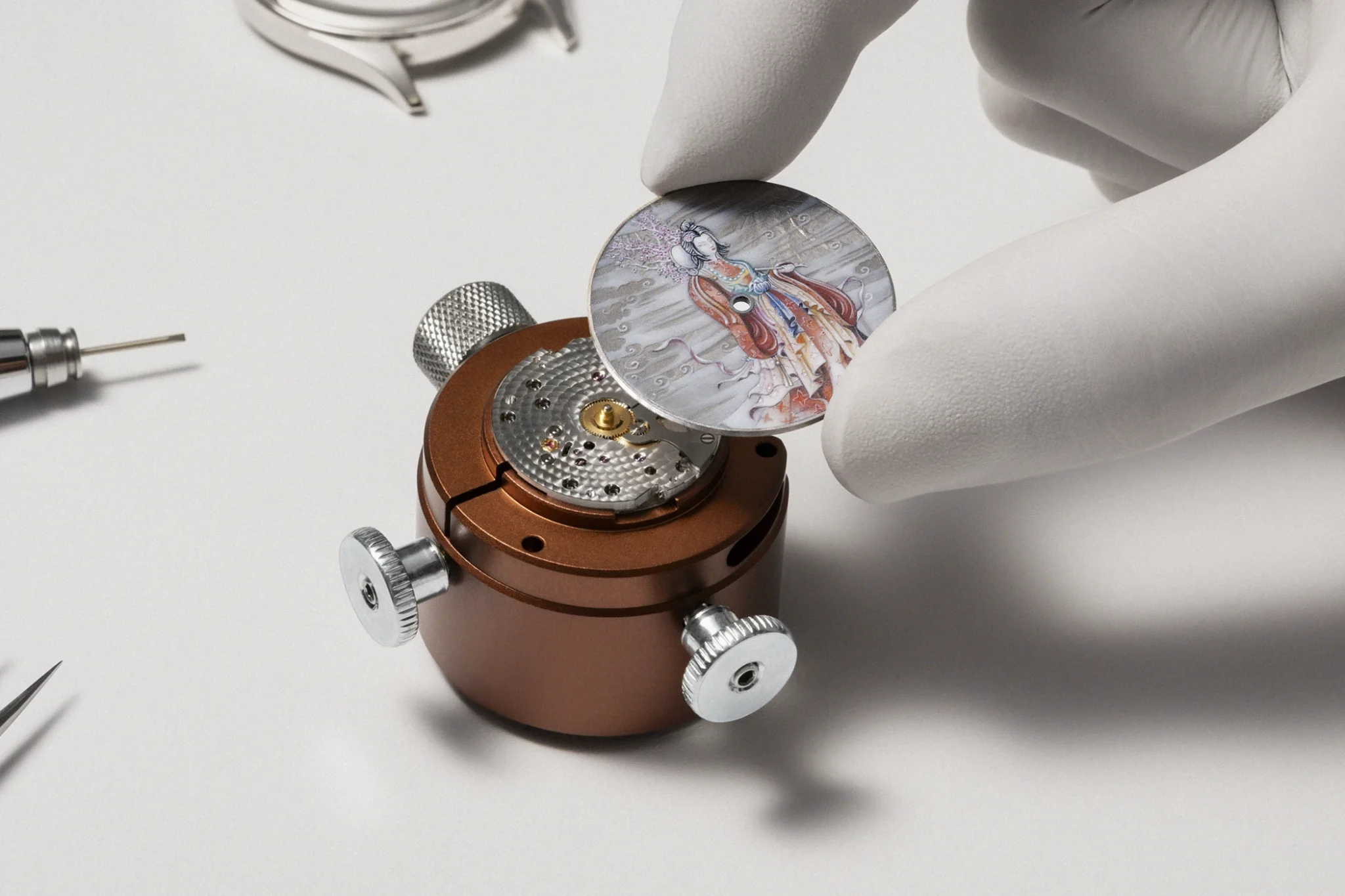
Les Cabinotiers Le Temps Divin: Asian culture
The cases
The final set of unique Les Cabinotiers Le Temps Divin watches take inspiration from Asian culture, the seasons, and the carefully preserved craft of wood marquetry. Each ‘Ode to the guardians’ watch in this limited series is a representation of the cyclical nature of time as understood through Asian culture, as presented through an ‘Azure dragon’, ‘Black tortoise’, ‘Vermilion bird’ and White tiger’ edition. Each of the four cases is designed to elegantly frame intricate wood marquetry scenes of sacred animals, symbolising the four seasons. Notably, the 42 mm white- or pink-gold cases are fairly slim, measuring 11.40 mm despite housing a tourbillon. Each case is accompanied by a hand-stitched Mississippiensis alligator leather strap with saddle-finish and large square scales.
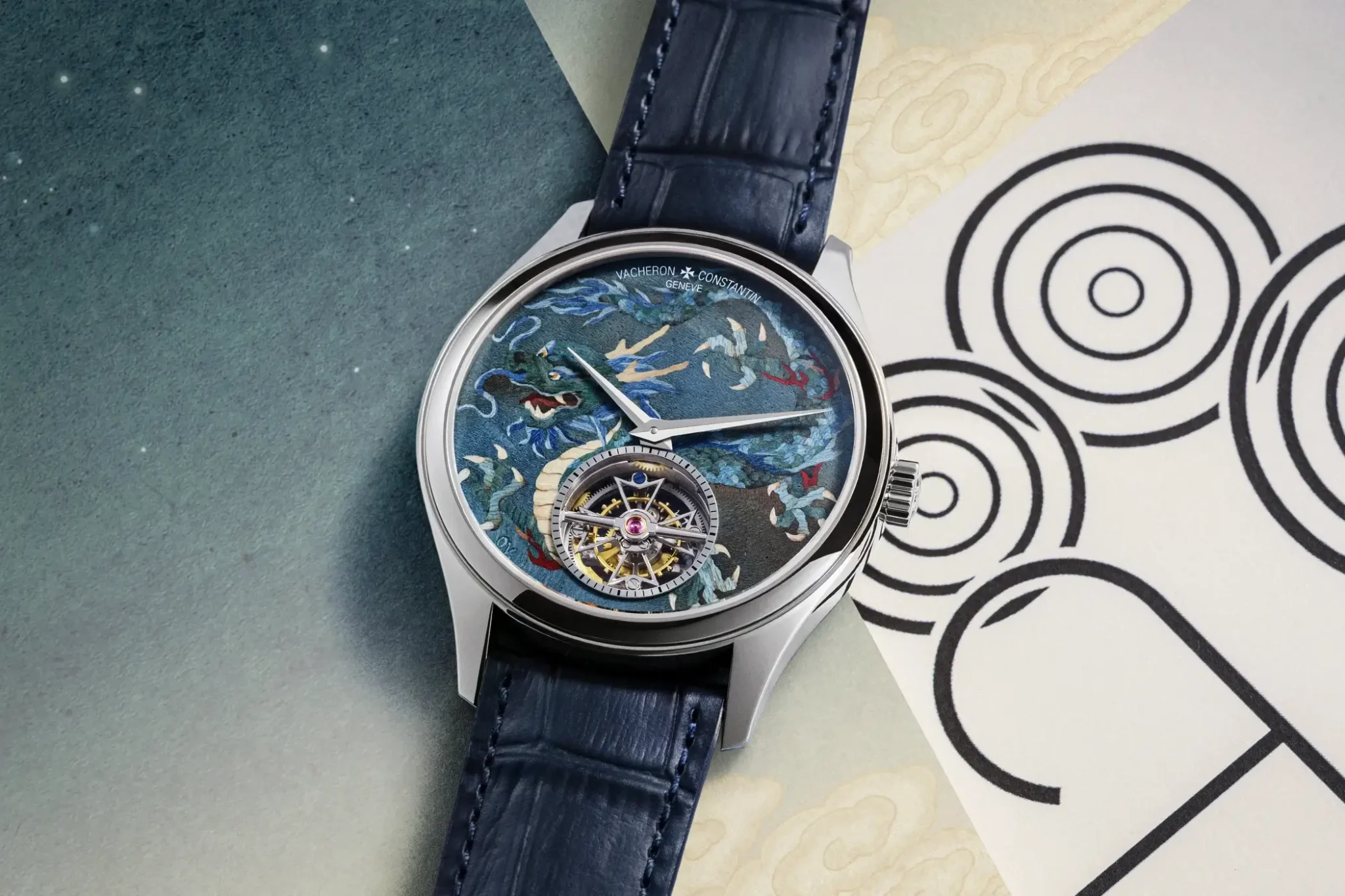
The ‘Ode to the guardians’ Azure Dragon edition
The dials
The dials feature four sacred animals from Asian mythology, each representing a season in the cycle of time. The stunning marquetry work brings these ancient symbols to life, evoking their spiritual significance and seasonal connections.
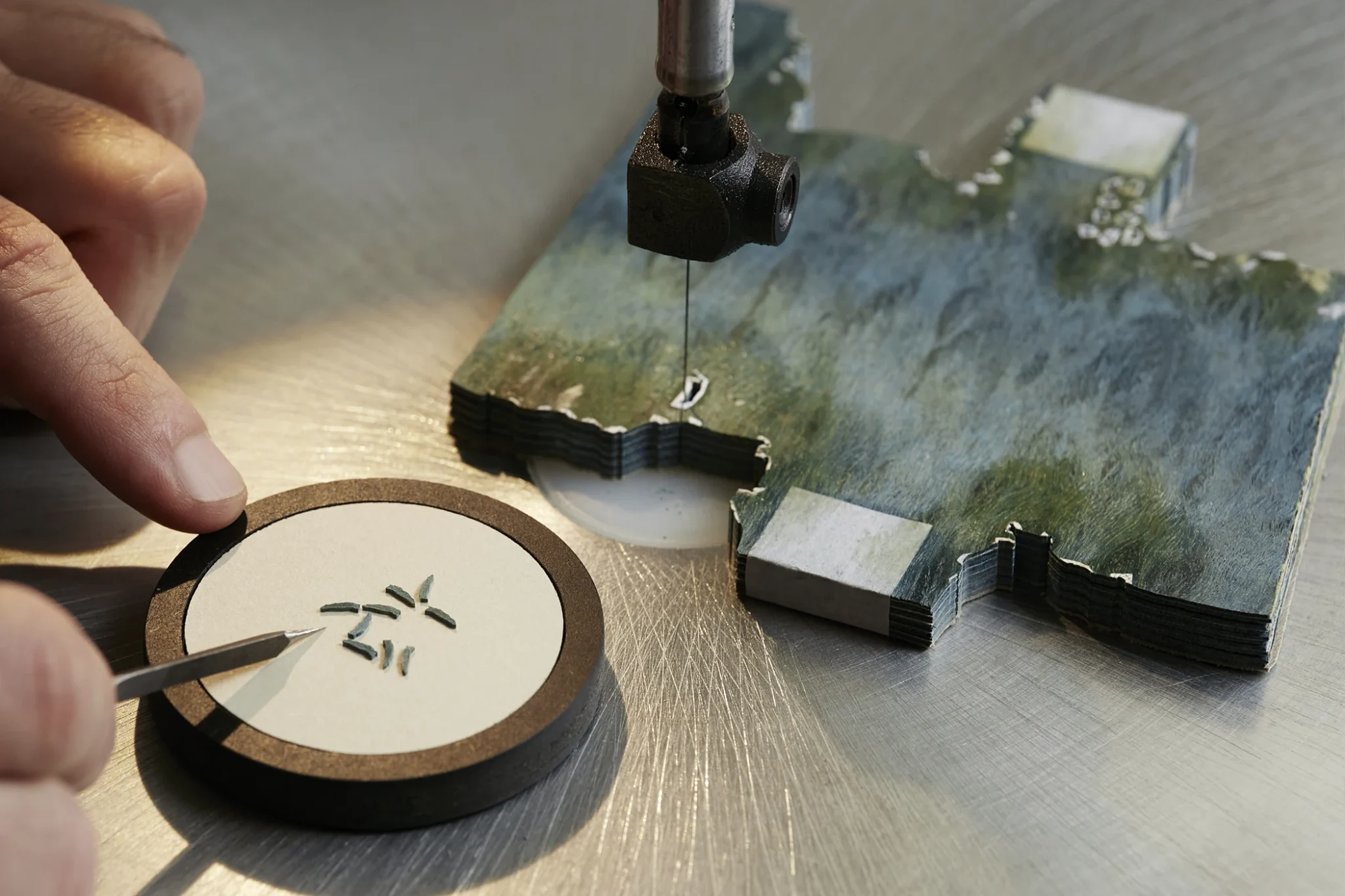
The ‘Azure Dragon’, embodying strength and power, serves as a depiction for spring. In Asian tradition, this creature governs the East and represents rejuvenation and vitality, capturing the essence of spring’s arrival. Meanwhile, the ‘Vermilion Bird’, a symbol of luck and prosperity, represents summer. Associated with the South, its vibrant plumage and fiery presence mirror the energy and warmth of summer. For autumn, the ‘White Tiger’ embodies courage and steadfastness, serving as a guardian of the West. The tiger’s fearlessness and wisdom is supposed to resonate with the introspective qualities of fall. Finally, winter is symbolised by the ‘Black Tortoise’, embodying wisdom and longevity. Governing the North, this figure of resilience stands for the quiet strength and endurance needed to persevere through winter’s challenges.
Work in progress: A craftsman works on the ‘Azure Dragon’
Each dial’s marquetry work is a remarkable feat, requiring both technical precision and artistic mastery. A typical marquetry artisan’s work involves using different types of wood in a variety of shades that are cut, organised, assembled and applied according to the motif to be created. The process involves 150 types of wood covering around 60 natural colours, sheets of veneer preserved at the right temperature and humidity. The process for this particular series commenced by selecting up to 12 types of wood in natural hues suited to each animal and its season, including sycamore, walnut, blue myrtle, and oak.
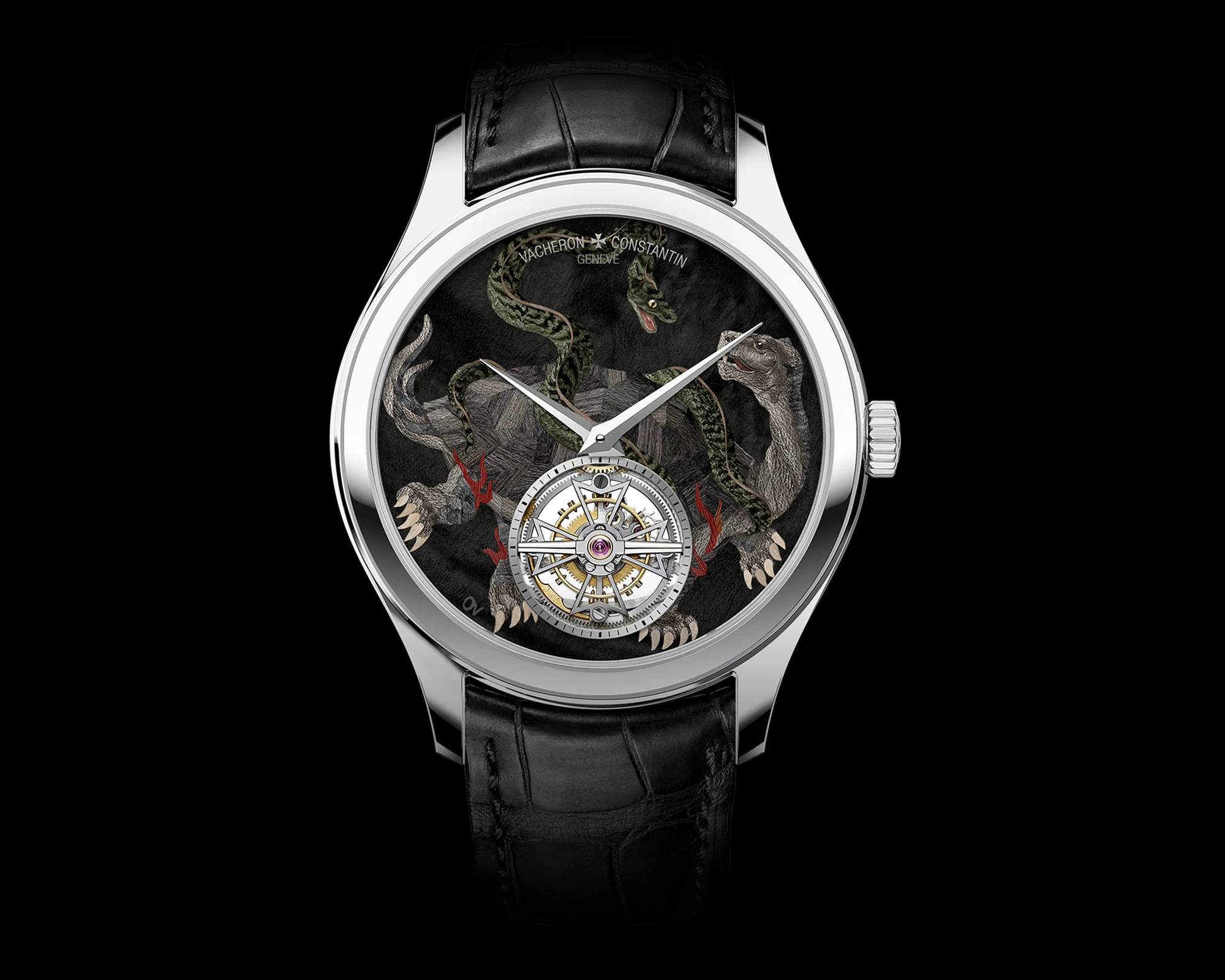
The Les Cabinotiers ‘Ode to the guardians’ Black Tortoise edition
The artisan prepared the motif on a scale four times the final dial size, ensuring clarity before reducing it and printing copies for tracing. The marquetry pieces were traced onto thin veneer layers, each only 0.6 mm thick, and carefully cut with a scroll saw for precision. Once cut, the tiny wooden pieces, sometimes as fine as 0.4 mm, were sanded, sometimes heated or tinted, and meticulously assembled like a puzzle. Each dial averages over 200 individual wood segments from various species, with the dragon alone requiring individual pieces for each scale. This painstaking craftsmanship by Les Cabinotiers, demanding an astounding month and a half per single dial, achieves a depth of detail and an organic richness in colour and texture that brings the mythical creatures to life – and means that the making of this series amounts to well over a year of work.
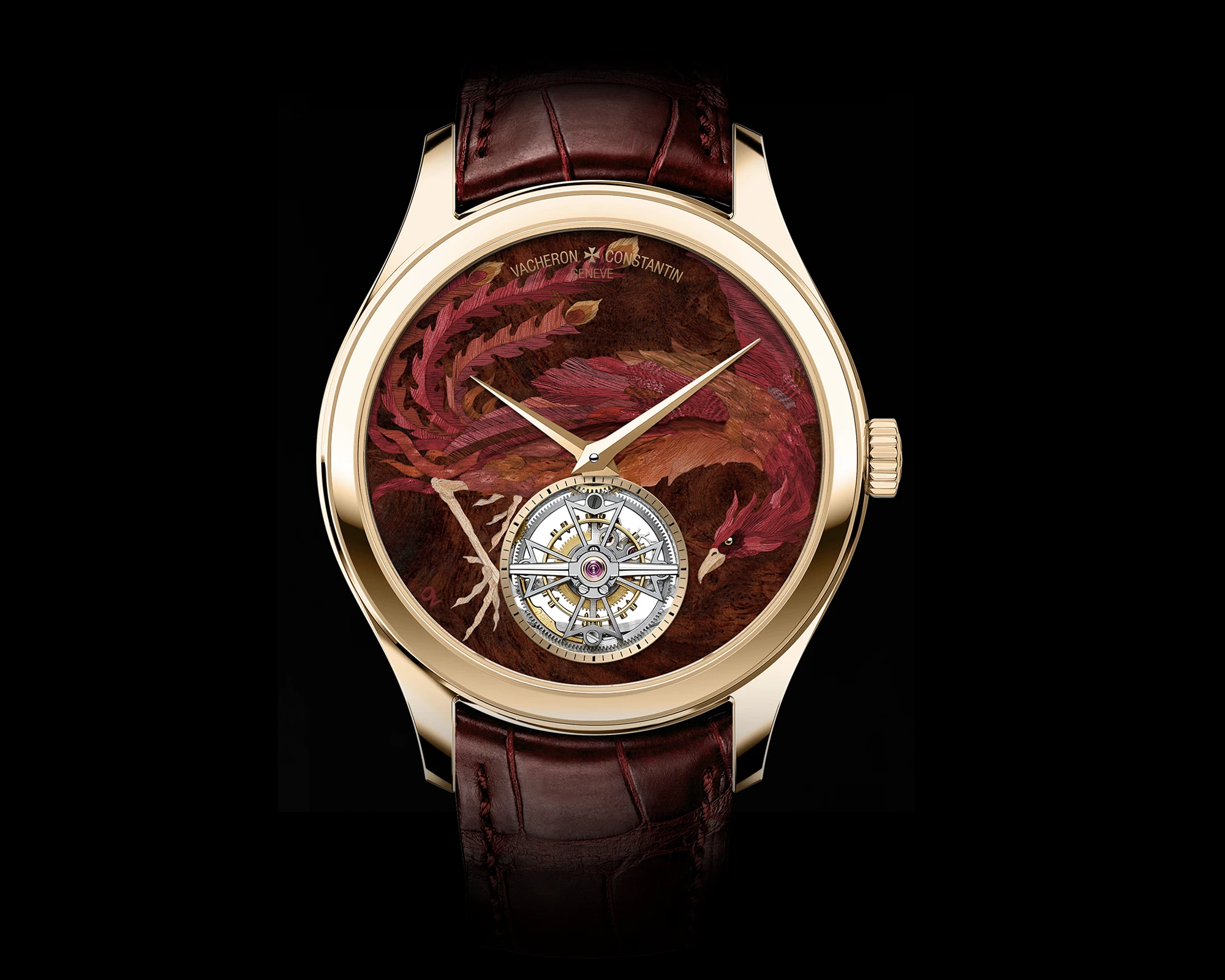
The Les Cabinotiers ‘Ode to the guardians’ Vermilion Bird edition
The movement
These atmospheric seasonal watches are powered by Vacheron Constantin’s ultra-thin calibre 2160 movement, a movement respected for its merging of precision with elegance. Measuring only 5.65 mm thick, the calibre operates at 18,000 vibrations per hour and offers an impressive 80-hour power reserve. Equipped with a tourbillon regulator, the 188-component movement integrates a peripheral rotor, creating a sleek, open design. This open architecture reveals the high level of finishing, from a circular-grained plate on the dial side to hand-bevelled bridges adorned with Côtes de Genève on the back. The gear train wheels are circular satin-finished, the screws chamfered and polished, and the tourbillon bar with its Maltese cross-shaped carriage bearing the small seconds indicated by a blackened screw is expertly rounded off by hand.
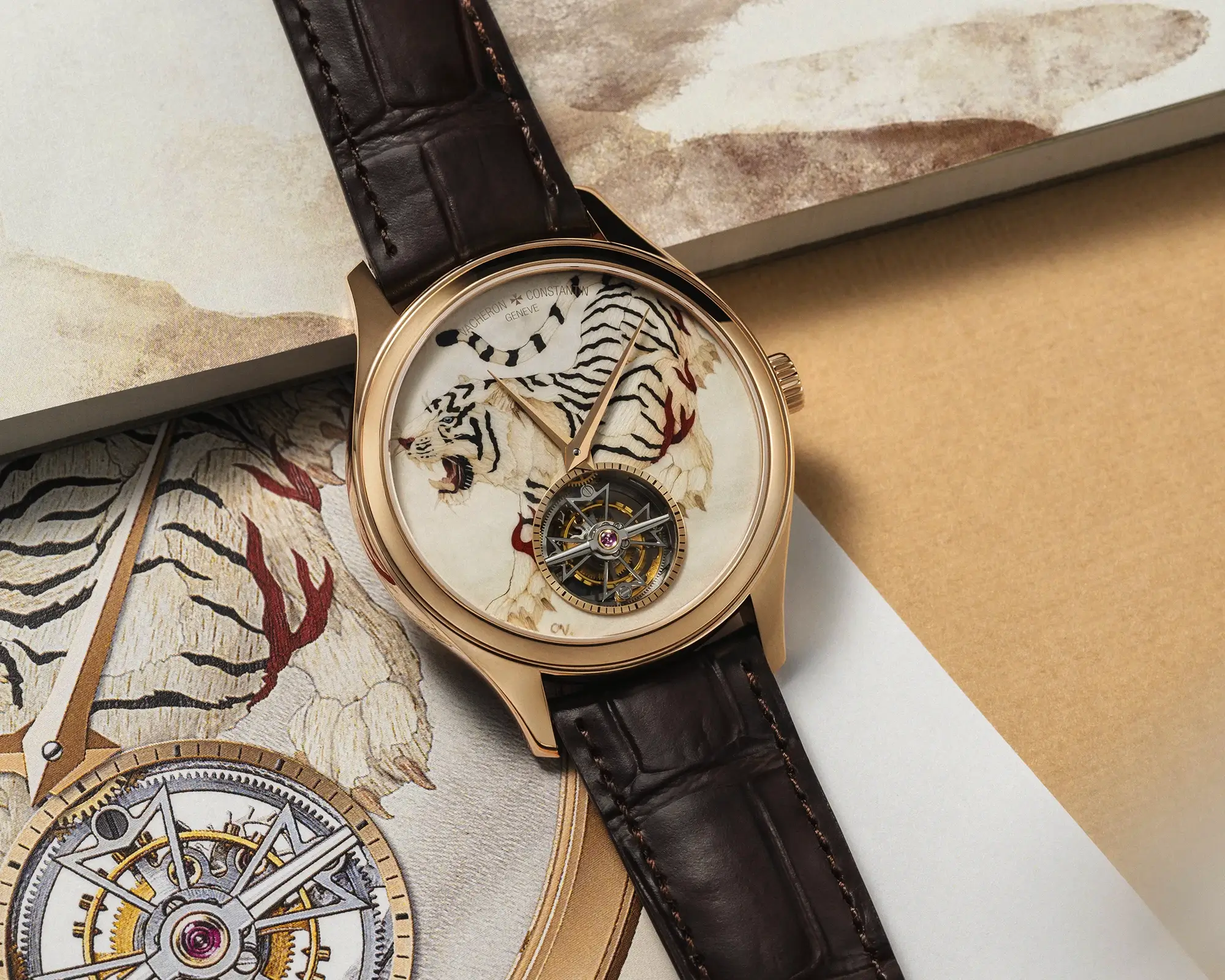
The Les Cabinotiers ‘Ode to the guardians’ White Tiger edition
Price of all models available upon request.
